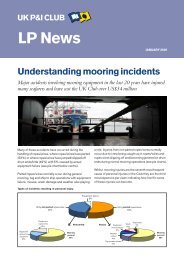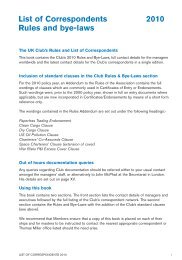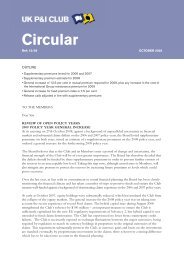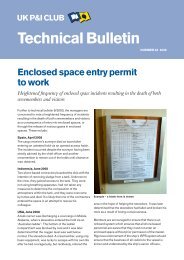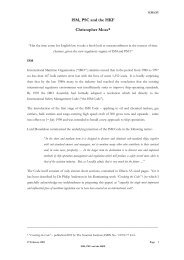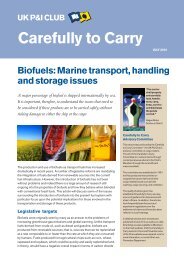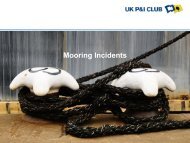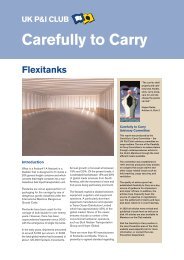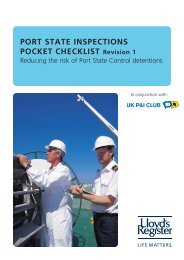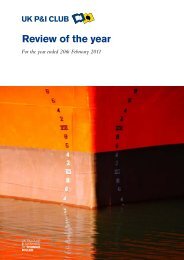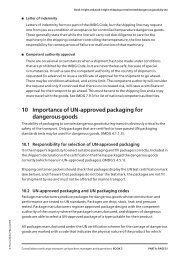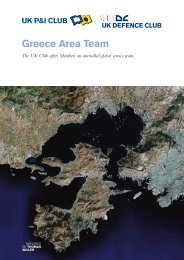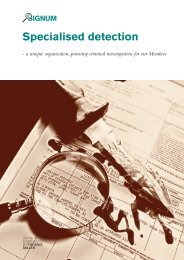Tanker contam checklist - UK P&I
Tanker contam checklist - UK P&I
Tanker contam checklist - UK P&I
Create successful ePaper yourself
Turn your PDF publications into a flip-book with our unique Google optimized e-Paper software.
How to prevent tanker cargo<br />
<strong>contam</strong>ination claims<br />
The cause of claims and how to avoid them<br />
during pre-loading, loading and unloading<br />
<strong>UK</strong> P&I CLUB<br />
IS MANAGED<br />
BY THOMAS<br />
MILLER
Recognising the causes of<br />
<strong>contam</strong>ination<br />
Shoreside<br />
● Residues of previous contents of storage tanks, lines and hoses.<br />
● Tank and line cleaning media, including water..<br />
● Other products, because of valve leakage or mis-operation or<br />
poor in-line blending<br />
● Fresh water or impurities carried over from the manufacturing<br />
process.<br />
● Fresh water from leaking heating coils or tank roofs.<br />
● Salt water from leaking sub-sea pipelines.<br />
Shipboard<br />
● Residues of previous contents of ship’s tanks, lines, pumps and<br />
hoses.<br />
● Dirty sounding and ullaging equipment.<br />
● Tank coating deficiencies.<br />
● Tank and line cleaning media, including water.<br />
● Other part cargoes, because of valve leakage, valve<br />
mis-operation or tank structural deficiency (e.g. bulkhead<br />
cracks).<br />
● Other part cargoes’ vapour via common inert gas systems.<br />
● Salt water from leaking tank hatches, sounding pipes and<br />
accesses.<br />
● Fresh water from leaking heating coils.<br />
● Copper leaching from alloys used to manufacture heating coils<br />
(e.g. alloy brass <strong>contam</strong>ination of jet fuel).
PRE-LOADING<br />
Ship suitability for the nominated<br />
cargo<br />
To ensure the ship can and does meet all the governing charter<br />
party’s conditions regarding cargo quality, consider:<br />
● Is the product included on the vessel’s International Maritime<br />
Organization (IMO) Certificate of Fitness, or is the product<br />
accepted under a tripartite agreement and is the original<br />
acceptance letter on board?<br />
● Can the different grades of cargo be arranged to maintain the<br />
degree of separation required? All chemicals must be<br />
separated by positive segregation.<br />
● Can the ship maintain the required cargo carriage and<br />
discharge temperature(s)?<br />
● Is the tank coating suitable for the nominated cargo? Some<br />
cargoes can permanently damage certain coatings, others<br />
make coatings soft for a while, during which time the range of<br />
cargoes they can tolerate is restricted. Refer to the coating<br />
manufacturer’s resistance lists. The listing of a cargo on the<br />
vessels Certificate of Fitness does not necessarily mean that<br />
the tank coating is suitable.<br />
● If applicable, is the cargo tank coating in good condition?<br />
● Have the cargo tanks and lines been suitably prepared to load<br />
the nominated cargo(es)? If applicable, have previous cargo<br />
vapours been reduced to less than 2% by volume so that<br />
potential flashpoint <strong>contam</strong>ination of nominated cargoes is<br />
eliminated?<br />
● With reference to the quality of multiple oil products loaded can<br />
two-valve segregation, on the liquid side, be maintained<br />
throughout the voyage? Chemicals must be carried under<br />
positive segregation.<br />
● Can the vapour side of each oil product parcel (inert gas and<br />
vapour relief systems) be segregated throughout the entire<br />
voyage? Chemicals must be positively segregated.<br />
Preparing the cargo plan<br />
● The cargo plan should minimise stress on the ship and eliminate<br />
the risk of cross-<strong>contam</strong>ination of different grades of cargo.<br />
● For multi-grade loadings, plan the use of pumps and pipelines<br />
to avoid or minimise commingling or downgrading.<br />
● Ensure that line displacements are calculated such as to avoid<br />
cross-<strong>contam</strong>ination.
● If liquid levels are too high, cargo from one tank can slosh<br />
through a common vent line to <strong>contam</strong>inate non-compatible<br />
cargo in an adjacent tank, if the ship rolls.<br />
● The vapours of one grade can put another grade out of<br />
specification. Gasoline vapours can <strong>contam</strong>inate kerosene,<br />
diesel and residual oils, if kept on a common venting line. If<br />
there is only one venting line, isolate one of the grades from the<br />
system.<br />
● Remember, certain cargoes cannot tolerate heat from an<br />
adjacent tank.<br />
● Heat reduces the effectiveness of inhibitors. Never stow<br />
inhibited cargoes adjacent to heated tanks.<br />
● To avoid stowing dangerously reactive cargoes in adjacent<br />
tanks, or allowing them to mix in lines, pumps or slop tanks,<br />
consult the US Coast Guard Code of Federal Regulations -<br />
Cargo Compatibility Guide (including the Exceptions List).<br />
Cargo system preparation and<br />
preventive maintenance<br />
● Flush and drain pumps, pipelines, valves and draining systems.<br />
● Washing water and previous cargo in dead ends and branch<br />
lines causes <strong>contam</strong>ination.<br />
● Thoroughly rinse away any cleansing agents used.<br />
● For cargoes that cannot tolerate water (e.g. jet fuel and<br />
lubricating oil) mop tanks and remove valve inspection plates to<br />
eliminate every trace of moisture.<br />
● Clean vent lines.<br />
● Chemical tankers should carry out their own wall wash tests<br />
prior to inspection.<br />
● When a tank is gas free, take the opportunity to inspect its<br />
structure and equipment and carry out maintenance where<br />
possible.<br />
● The condition of tank coatings should be monitored but<br />
specialist attention is usually required if they are found to be<br />
defective.<br />
● Never overlook the rules for safe confined space entry.<br />
● Clean the gasket face of tank openings; check rubber gaskets<br />
and replace if necessary; replace fibre gaskets and tighten<br />
hatch lids correctly.<br />
● Test for oil, water and vapour tightness by using the inert gas<br />
system to pressurise tanks.<br />
● Check valves spindles for vapour leaking from glands.
● Make cold weather preparations if necessary.<br />
● Regularly check and maintain:<br />
● All cargo valves, pipelines, expansion joints and couplings by<br />
pressure testing<br />
● Seachest valves and overboard discharge valves<br />
● High level and pump room alarms<br />
● Hydraulic valve operating systems<br />
● CCR and pump room instrumentation<br />
● Cargo pumps, stripping pumps, draining systems and COW<br />
machines to prevent extended discharge times<br />
● Pressure/vacuum valves to prevent vapour losses and cross<br />
<strong>contam</strong>ination<br />
● Sampling and measuring devices (Whessoe gauges, trimodal<br />
gauges, explosimeters, oxygen meters)<br />
● Heating coils, using air or fresh water to check for leaks<br />
(which cause <strong>contam</strong>ination) or blockages (which cause<br />
cargo to solidify). If coils are not intact, they may contain<br />
residues of previous cargoes<br />
● The inert gas system, to ensure it can maintain required<br />
pressure; reduce oxygen content to required level; avoid<br />
<strong>contam</strong>inating cargo with soot deposits from inadequately<br />
scrubbed flue gases.<br />
● Ship’s staff must be trained in the use and calibration of<br />
electronic equipment. It must also be calibrated and certified by<br />
an approved agency yearly.<br />
● Records of annual calibration and comparison of all gauges<br />
(level, temperature and pressure – include remote gauges) must<br />
be kept. These records must show all the observed readings – a<br />
simple statement ‘all gauges tested OK’ is NOT acceptable.<br />
● Records of testing for all cargo equipment (heating coils,<br />
pressure relief valves, manifold valve closing times etc.) must be<br />
kept.<br />
LOADING<br />
Working with terminal representatives<br />
The key meeting should not be limited to filling out cargo and safety<br />
<strong>checklist</strong>s – it is in the ship’s interest for the chief officer to take this<br />
opportunity to build a strong working relationship with shore<br />
personnel.<br />
The chief officer must, in order to monitor the transfer from shore to
ship efficiently, ascertain the following information from the terminal<br />
representatives:<br />
● How the ship and the shore will communicate.<br />
● Grade(s) and quantity(ies) of cargo(es) to be loaded and<br />
whether it will be a ship or shore stop.<br />
● Density(ies) of cargo(es) to be loaded and whether they are<br />
expressed ‘in air’ or ‘in vacuum’.<br />
● Has an MSDS been provided by the loading terminal for each<br />
product to be carried and does it state the minimum<br />
requirements for safe transportation of the cargo (see IBC<br />
Code – Section 16.2). Do NOT use old MSDS as the<br />
information contained may be incorrect.<br />
● Whether the shore pipeline is dedicated.<br />
● Whether the shore pipelines are full or empty at the start of<br />
loading. Details of any shore pipeline displacements planned to<br />
include length, nominal diameter and volume of pipelines used<br />
(from ship to reception tank).<br />
● Number of shore tanks to be loaded from, and the quantity,<br />
temperature and density of cargo in each.<br />
● Whether loading will be interrupted for shore tank changeovers.<br />
● If change-overs are to take place without stops, that the ship<br />
receives notification of every change for sampling purposes.<br />
● Whether the ship will be receiving two sets of samples from<br />
each shore tank used (i.e. one for the receiver and one for the<br />
shipowner). If not, log that the request was made and refused.<br />
Working with the cargo inspector<br />
Tank inspections<br />
● Remember, an ‘independent inspector’ is independent in name<br />
only. Expect him to give the ship’s interests low priority, and<br />
make sure he is accompanied by an officer at all times.<br />
● An experienced officer may well be more expert than the<br />
inspector.<br />
● Tanks cannot be entered where local regulations insist on<br />
constant operation of the inert gas system but, whenever<br />
possible, make sure that the inspector checks every tank<br />
thoroughly.<br />
● If the ship’s pipelines have been drained, demonstrate this to<br />
him and ensure it appears on the inspection certificate.<br />
● Outside the chemical trade, tank inspections are often<br />
subjective so, if you do not agree with the inspector, try to reach
a commercial solution – always faster and cheaper than a legal one.<br />
● As soon as it becomes apparent that you cannot agree, protest.<br />
Remember the Club is always there to support you, usually with a<br />
correspondent on the spot.<br />
Taking samples<br />
● Adopt a sampling procedure that satisfies the relevant<br />
authorities.<br />
● Make sure the ship has the right equipment, including clean<br />
bottles, seals and labels.<br />
● Label samples with the following information:<br />
● Ship’s name<br />
● Date and time<br />
● Location<br />
● Cargo name<br />
● Operational status (e.g. ‘after loading’)<br />
● Sample source (e.g. ‘tank number….’)<br />
● Sample type (e.g. ‘top’: ‘composite’)<br />
● Identity of sampler<br />
● Seal number.<br />
● Make sure each sample is signed and sealed, preferably by the<br />
independent inspector.<br />
● Note the particulars of every sample taken for the ship’s<br />
purposes in a sampling log.<br />
● Present the inspector with a list of samples drawn and retained<br />
by the ship for acknowledgement and signature.<br />
● Require any party to whom a sample is handed over to sign a<br />
receipt for it.<br />
● If the sample is the subject of a cargo dispute, then always<br />
obtain written permission from vessels operators before<br />
handing over a sample to a third party.<br />
● Store samples in a secure space which is cool, well ventilated<br />
and not exposed to light. Samples must never be stowed within<br />
the accommodation, and must be stowed in cell-divided spaces<br />
made of material resistant to the cargo and with adequate<br />
ventilation arrangements.<br />
● Since the Hague Rules allow claims to be presented up to a<br />
year after the event, samples should not be disposed of until<br />
that period of time has elapsed.
UNLOADING<br />
Monitoring the discharge of cargo<br />
● Maintain a minimum of two valve separation throughout the<br />
discharge of multiple grade oil products. Chemicals must be<br />
maintained under positive segregation.<br />
● Valves should be sealed (if they were not sealed in the<br />
loadport) and the seals pointed out to the inspector and<br />
logged.<br />
● If possible, leave seals in place until discharge is completed<br />
and ask the inspector to note the fact.<br />
● The most easily <strong>contam</strong>inated grades should be discharged<br />
first, if possible.<br />
● If any grade cannot tolerate contact with residues of the grade<br />
before, strip the cargo line.<br />
● If necessary flush the line with the second grade and re-strip –<br />
it is better to lose part of the cargo through downgrading than<br />
to <strong>contam</strong>inate all of it and the shore tank besides.<br />
● A watch officer discovering <strong>contam</strong>ination should:<br />
● Stop discharging the relevant cargo<br />
● Close that system’s valves<br />
● Advise the chief officer, who advises the master, who<br />
contacts the owner and his local P&I correspondent.<br />
● The master should:<br />
● Sample the remaining cargo and request testing<br />
● Await instructions from the owner<br />
● Never try to conceal a handling error which may result in<br />
<strong>contam</strong>ination. The sooner problems are identified, the less the<br />
owner’s potential exposure.<br />
GENERAL COMMENTS<br />
Sampling during loading and<br />
discharging<br />
A leading firm of cargo surveyors reports that approximately 40%<br />
of alleged shipboard <strong>contam</strong>ination problems are, on<br />
investigation, found to be shore related.<br />
● Samples showing that the condition of the cargo did not<br />
change between loading and discharge provide the best<br />
defence against unfounded <strong>contam</strong>ination claims.
● If the laboratory analysis report is to be right, the sample must be<br />
right too – an inspector is as prone to error as the next man.<br />
● The inspector must be accompanied at all times, to ensure that<br />
the sampling procedure satisfies the relevant authorities.<br />
● Refer to the Energy Institute (formerly Institute of Petroleum)<br />
Petroleum Measurement Manual or the American Petroleum<br />
Institute (API) Manual of Petroleum Measurement Standards to<br />
be certain you know what is required.<br />
See the next page for addresses of these organisations.<br />
● If the inspector fails to do something he should, or does it wrong,<br />
point it out to him – and log anything he does not put right.<br />
● Log any faults with his equipment and any occasions when he<br />
borrows the ship’s equipment.<br />
● As well as any samples he takes for the consignee, the receiver<br />
and his own firm, ask the inspector to take another set for the<br />
ship.<br />
● If he refuses, note it in the log – and take your own.<br />
● Chief officers should ensure they receive two sets of shore tank<br />
samples for each grade: one set for delivery to the receiver’s<br />
agent; the other to be retained by the ship.<br />
● Asking the inspector to take starting samples at the manifold,<br />
with the manifold valve closed if possible, at the start of loading<br />
operations, is the best way to detect <strong>contam</strong>ination or<br />
commingling in shore lines.<br />
● Make sure first foot samples are taken to verify that the ship’s<br />
lines are clean.<br />
● Discourage the inspector from subjecting them to visual analysis<br />
only, while loading continues.<br />
● Loading should be stopped while proper tests are carried out,<br />
particularly when the specification is critical.<br />
● If any samples are out of specification, advise the charterer<br />
without delay.<br />
● Even if tests reveal no problems, the ship must retain its<br />
duplicate samples in case of any later dispute.<br />
● Carry out spot checks at the manifold whenever practicable<br />
during loading, particularly after any shore stops, and preferably<br />
accompanied by the inspector, or a representative of the<br />
terminal.<br />
● Accompany the inspector when he opens the sealed unit of any<br />
composite sampler.<br />
● ‘After-loading’ samples should be taken from upper, middle and<br />
lower layers of each cargo tank.
● If the cargo is to be treated with an additive, the fact should be<br />
recorded on the bill of lading. Unless you are certain that the<br />
shipper and receiver have agreed to this taking place after<br />
loading, require any party proposing to do this to sign for receipt<br />
of a letter protesting the procedure – before he carries it out.<br />
● Make sure you receive a certificate in respect of cargoes that<br />
are inhibited and that the certificate specifies the information<br />
required under IBC Code 15.13.3.<br />
● At the discharge port, in-line samples of each grade of cargo<br />
should be taken at the manifold:<br />
● At the start of discharging<br />
● Once during every watch that the grade is being discharged<br />
● During stripping.<br />
● If the inspector fails to take any of these samples, the ship<br />
should take its own.<br />
● Make sure the inspector samples any free water found, so that<br />
its source can be established.<br />
● Sampling bunker tanks after loading and before discharging<br />
helps defend against claims that cargo has been used as<br />
bunkers.<br />
Useful addresses<br />
Energy Institute (formerly Institute of Petroleum)<br />
61 New Cavendish Street, London, London, W1G 7AR<br />
Tel: +44 (0)20 7467 7111<br />
www.energyinst.org<br />
American Petroleum Institute (API)<br />
1220 L Street, NW, Washington DC 20005-4090<br />
Tel: +1 202 682 8000<br />
www.api.org<br />
Acknowledgments: Capt David Payne Associated Petroleum Consultants Ltd
<strong>Tanker</strong> Matters video<br />
<strong>Tanker</strong> cargo claims – how they are caused,<br />
and how to avoid them<br />
The <strong>UK</strong> Club’s Cargo Matters series of videos aims to increase<br />
awareness of the causes of P&I claims for cargo damage and<br />
loss. <strong>Tanker</strong> Matters focuses on some of the most frequent<br />
causes of tanker cargo claims and how to avoid them.<br />
The DVD can be viewed continuously, or scene by scene:<br />
● Introduction<br />
● Ensuring the ship is suitable for the cargo<br />
● The cargo plan<br />
● Preparing cargo systems<br />
● Before loading – the key meeting and lining up<br />
● Loading<br />
● The loaded voyage<br />
● Discharging<br />
● Summary
<strong>UK</strong> P&I CLUB<br />
IS MANAGED<br />
BY THOMAS<br />
MILLER<br />
For further information please contact:<br />
Loss Prevention Department, Thomas Miller P&I Ltd<br />
Tel: +44 20 7204 2307. Fax +44 20 7283 6517<br />
Email: karl.lumbers@thomasmiller.com




